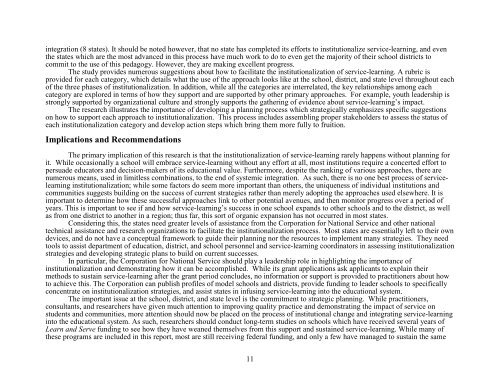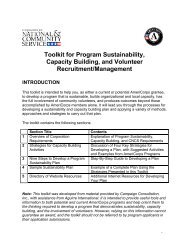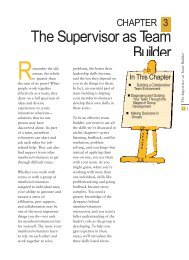MAKE IT LAST FOREVER: THE ... - National Service Resource Center
MAKE IT LAST FOREVER: THE ... - National Service Resource Center
MAKE IT LAST FOREVER: THE ... - National Service Resource Center
You also want an ePaper? Increase the reach of your titles
YUMPU automatically turns print PDFs into web optimized ePapers that Google loves.
integration (8 states). It should be noted however, that no state has completed its efforts to institutionalize service-learning, and even<br />
the states which are the most advanced in this process have much work to do to even get the majority of their school districts to<br />
commit to the use of this pedagogy. However, they are making excellent progress.<br />
The study provides numerous suggestions about how to facilitate the institutionalization of service-learning. A rubric is<br />
provided for each category, which details what the use of the approach looks like at the school, district, and state level throughout each<br />
of the three phases of institutionalization. In addition, while all the categories are interrelated, the key relationships among each<br />
category are explored in terms of how they support and are supported by other primary approaches. For example, youth leadership is<br />
strongly supported by organizational culture and strongly supports the gathering of evidence about service-learning’s impact.<br />
The research illustrates the importance of developing a planning process which strategically emphasizes specific suggestions<br />
on how to support each approach to institutionalization. This process includes assembling proper stakeholders to assess the status of<br />
each institutionalization category and develop action steps which bring them more fully to fruition.<br />
Implications and Recommendations<br />
The primary implication of this research is that the institutionalization of service-learning rarely happens without planning for<br />
it. While occasionally a school will embrace service-learning without any effort at all, most institutions require a concerted effort to<br />
persuade educators and decision-makers of its educational value. Furthermore, despite the ranking of various approaches, there are<br />
numerous means, used in limitless combinations, to the end of systemic integration. As such, there is no one best process of servicelearning<br />
institutionalization; while some factors do seem more important than others, the uniqueness of individual institutions and<br />
communities suggests building on the success of current strategies rather than merely adopting the approaches used elsewhere. It is<br />
important to determine how these successful approaches link to other potential avenues, and then monitor progress over a period of<br />
years. This is important to see if and how service-learning’s success in one school expands to other schools and to the district, as well<br />
as from one district to another in a region; thus far, this sort of organic expansion has not occurred in most states.<br />
Considering this, the states need greater levels of assistance from the Corporation for <strong>National</strong> <strong>Service</strong> and other national<br />
technical assistance and research organizations to facilitate the institutionalization process. Most states are essentially left to their own<br />
devices, and do not have a conceptual framework to guide their planning nor the resources to implement many strategies. They need<br />
tools to assist department of education, district, and school personnel and service-learning coordinators in assessing institutionalization<br />
strategies and developing strategic plans to build on current successes.<br />
In particular, the Corporation for <strong>National</strong> <strong>Service</strong> should play a leadership role in highlighting the importance of<br />
institutionalization and demonstrating how it can be accomplished. While its grant applications ask applicants to explain their<br />
methods to sustain service-learning after the grant period concludes, no information or support is provided to practitioners about how<br />
to achieve this. The Corporation can publish profiles of model schools and districts, provide funding to leader schools to specifically<br />
concentrate on institutionalization strategies, and assist states in infusing service-learning into the educational system.<br />
The important issue at the school, district, and state level is the commitment to strategic planning. While practitioners,<br />
consultants, and researchers have given much attention to improving quality practice and demonstrating the impact of service on<br />
students and communities, more attention should now be placed on the process of institutional change and integrating service-learning<br />
into the educational system. As such, researchers should conduct long-term studies on schools which have received several years of<br />
Learn and Serve funding to see how they have weaned themselves from this support and sustained service-learning. While many of<br />
these programs are included in this report, most are still receiving federal funding, and only a few have managed to sustain the same<br />
11










